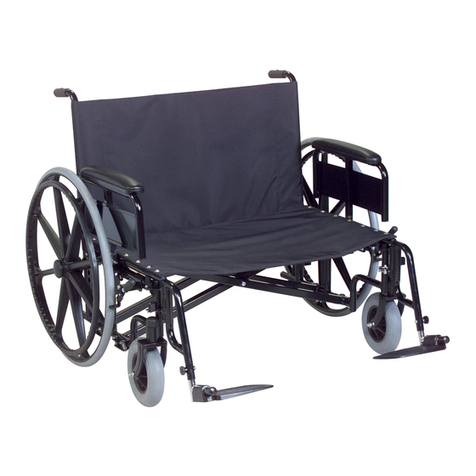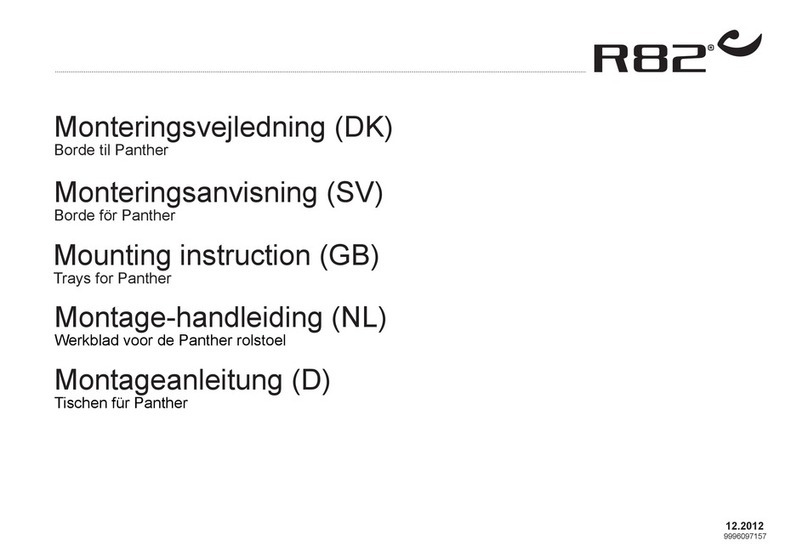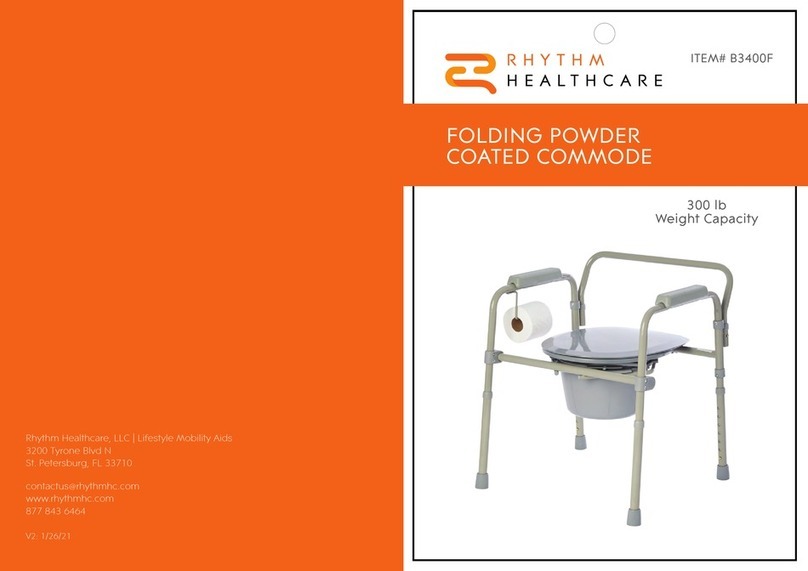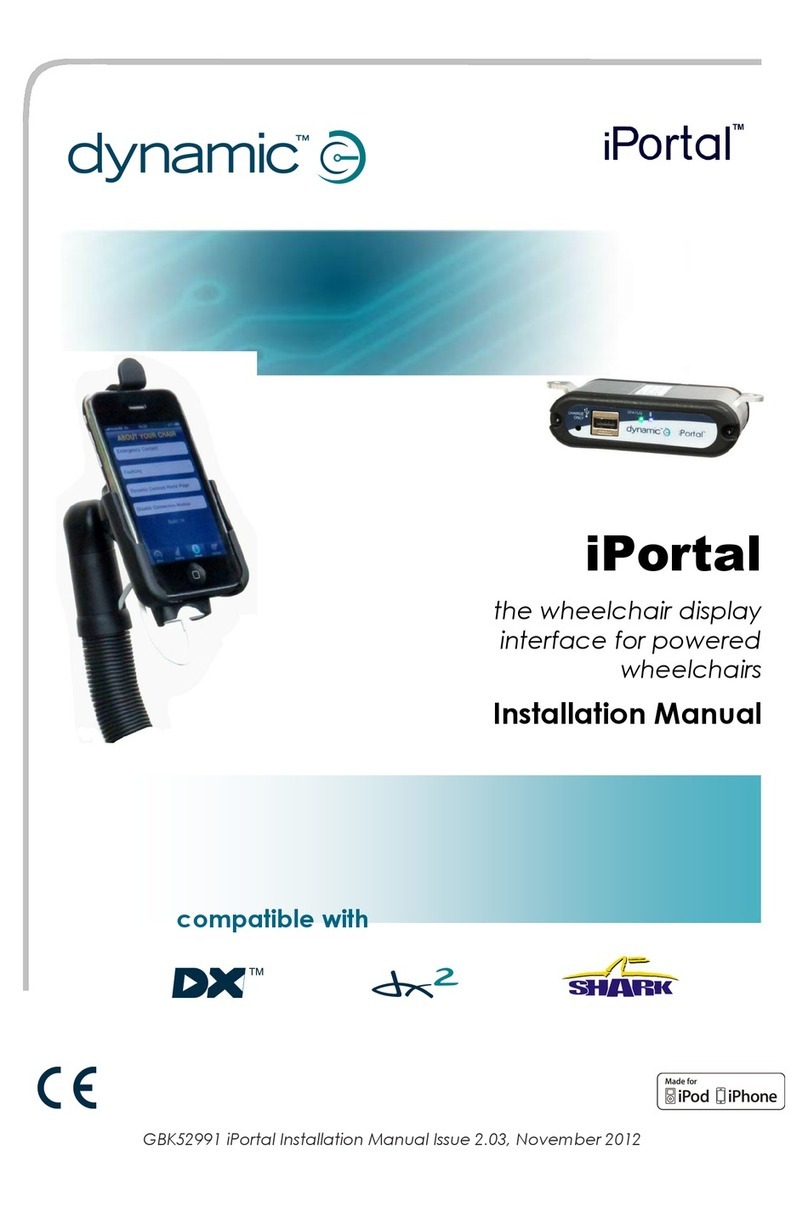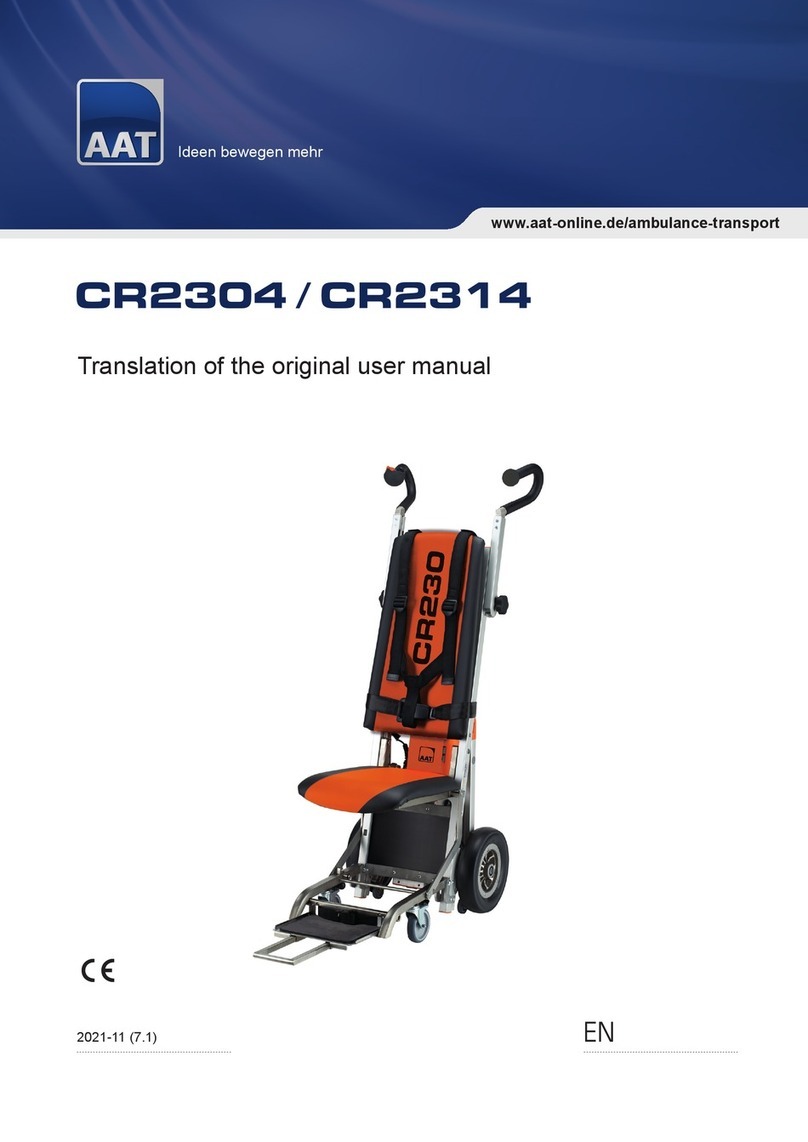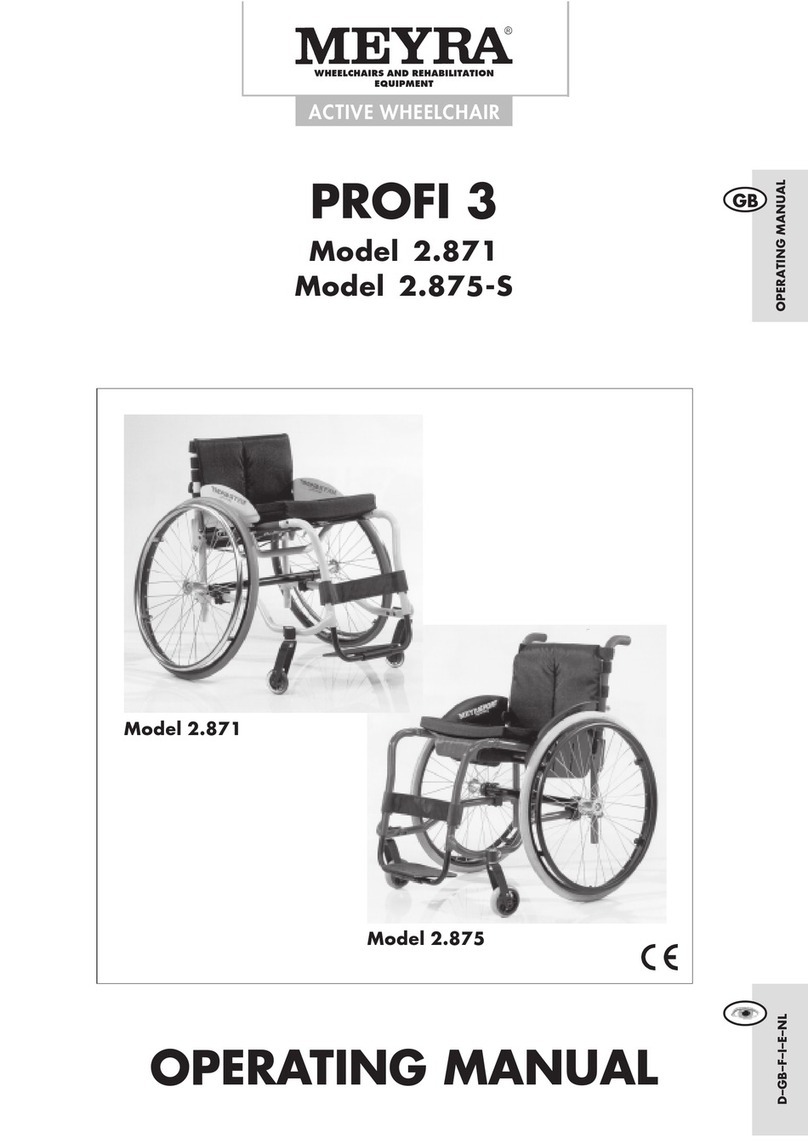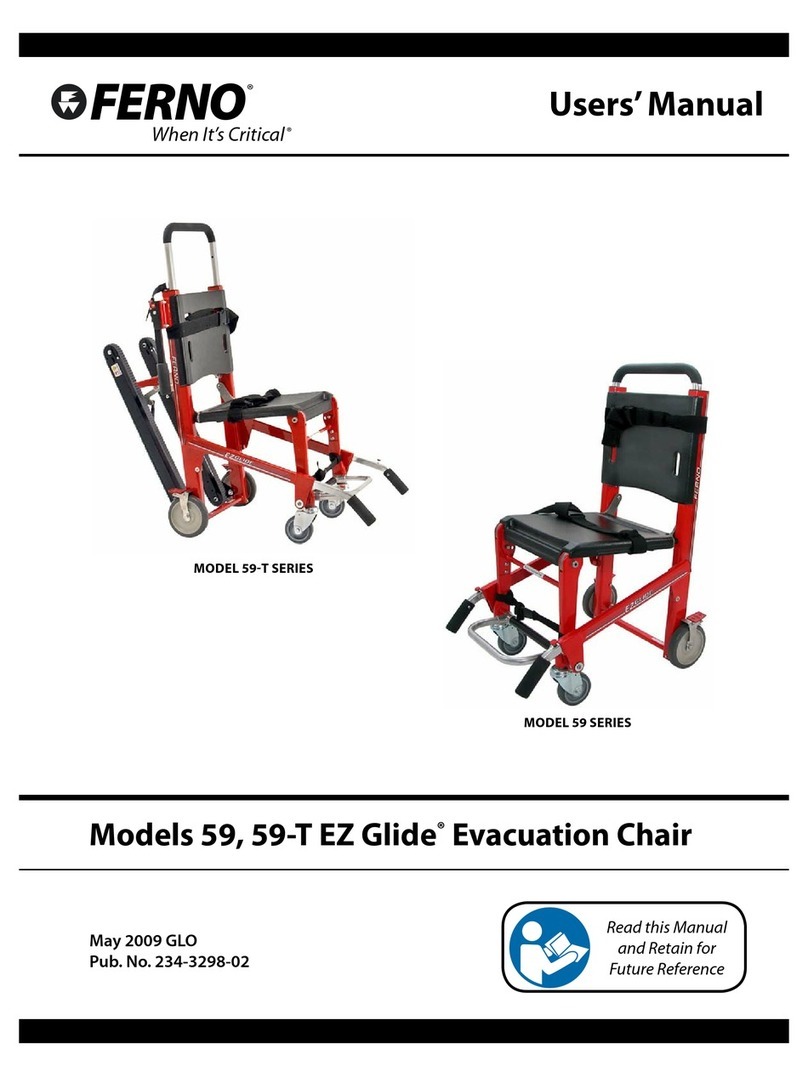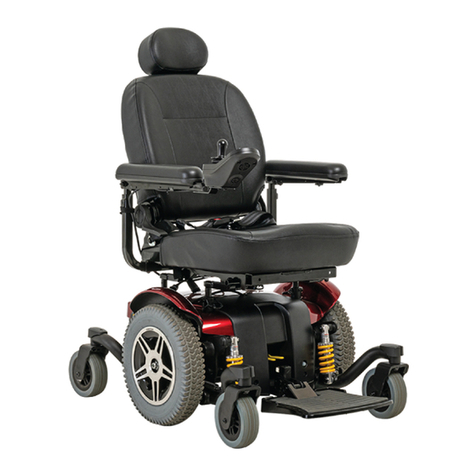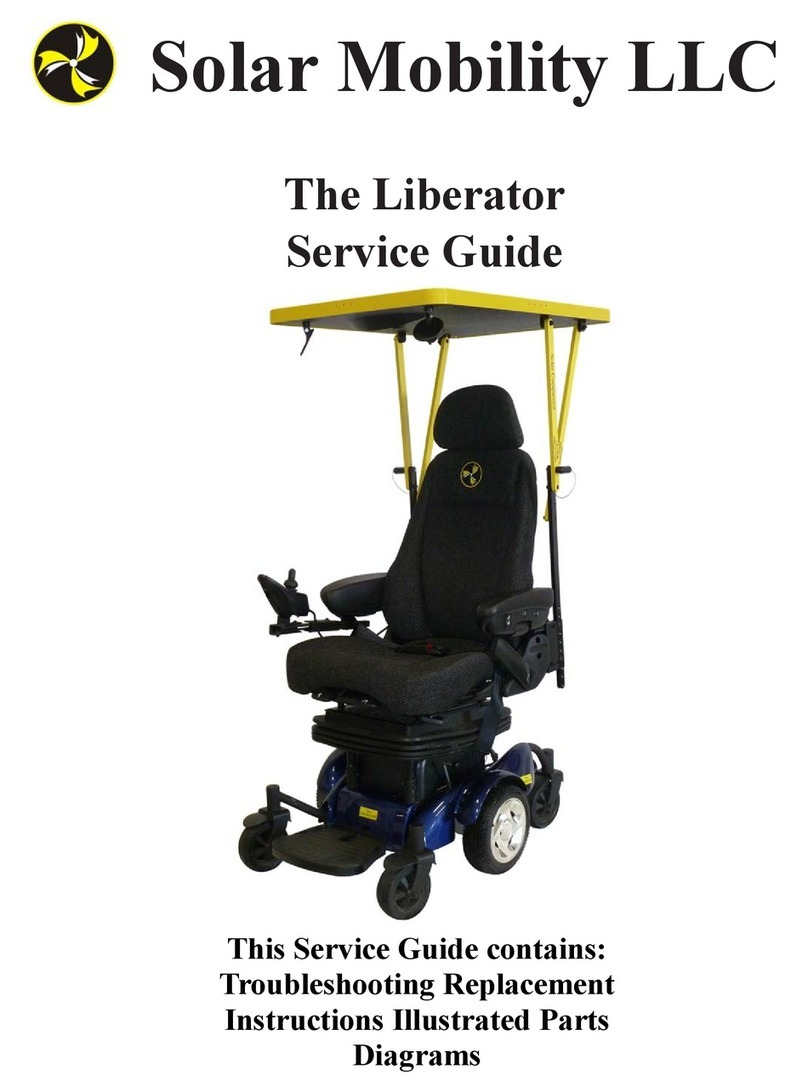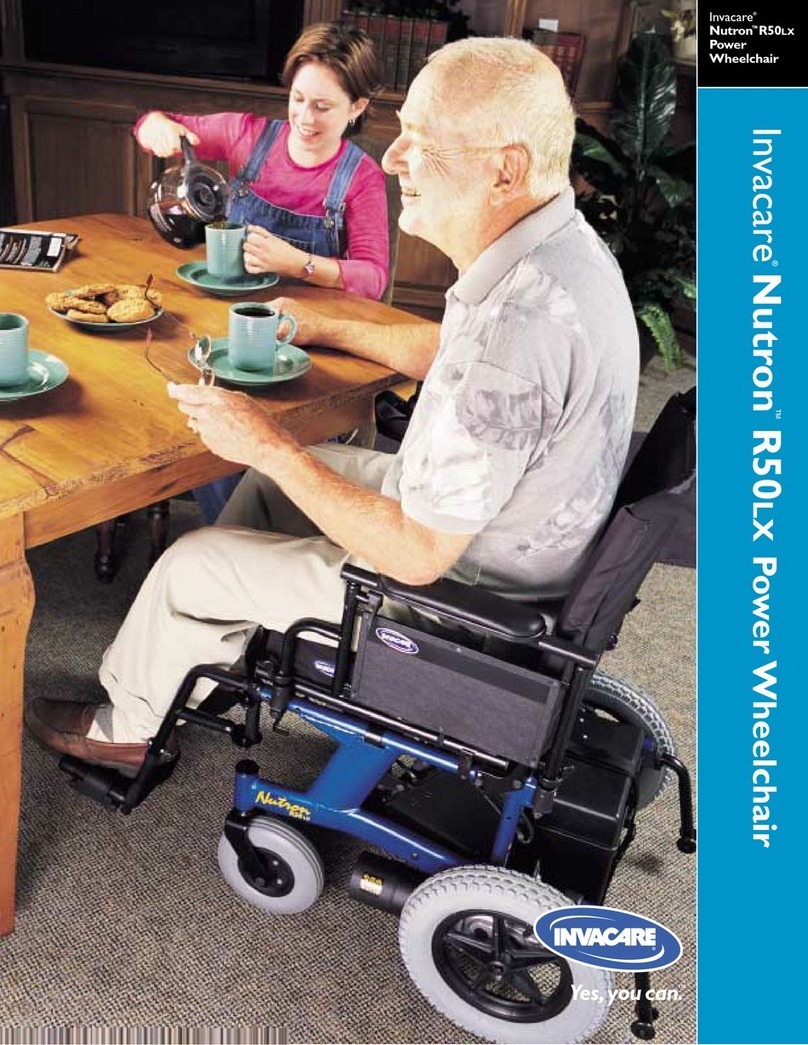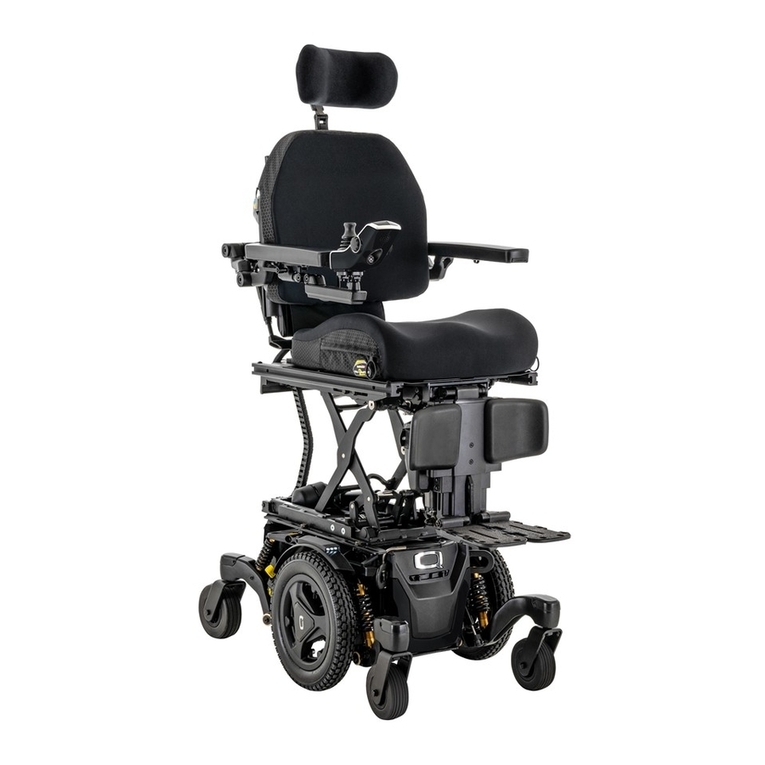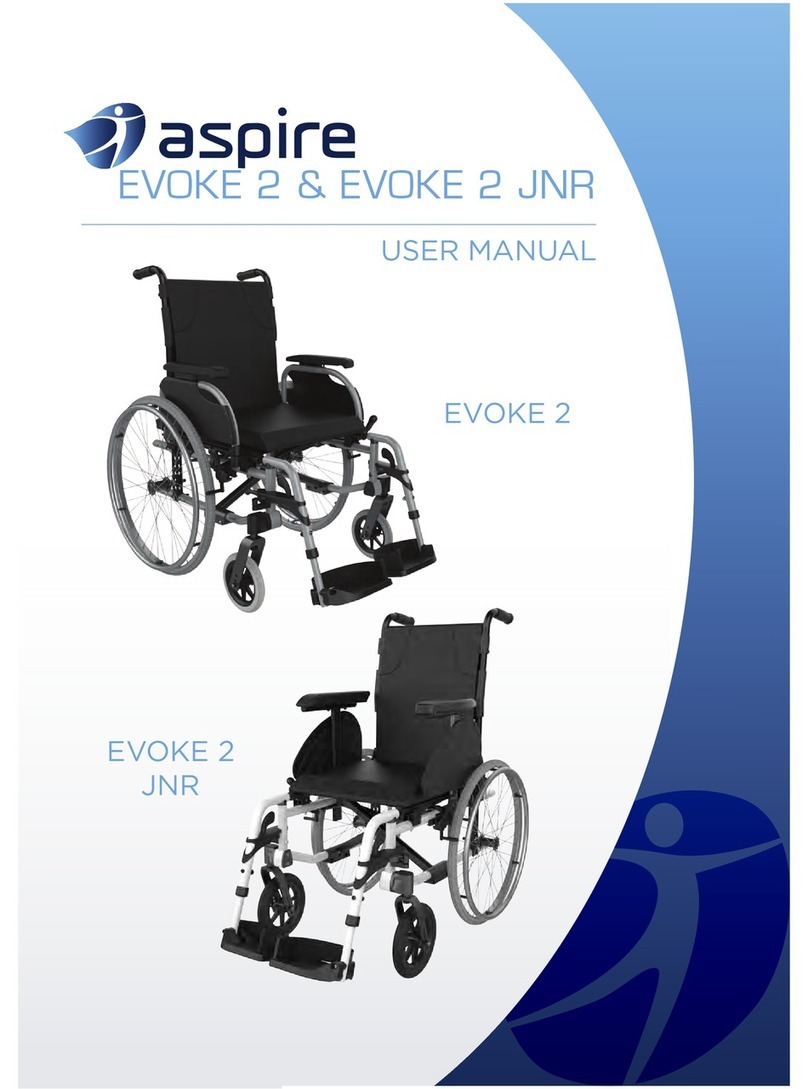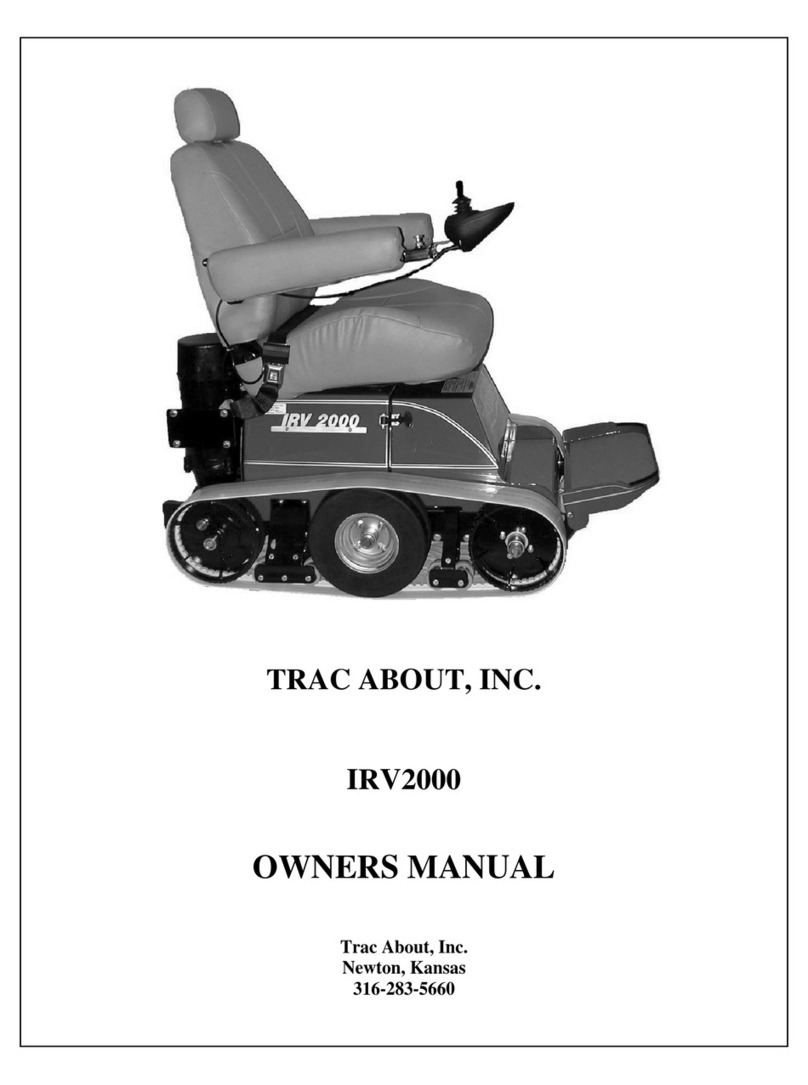GENDRON REGENCY XLC 7700 User manual

Form No. 7700 Manual (12/14) © Gendron
2000
Owner’s
Manual
REGENCY POWER WHEELCHAIR
MODEL: 7700
DANGER: ELECTROMAGNETIC INTERFERENCE (EMI) MAY CAUSE
ERRATIC, UNINTENTIONAL OR UNCONTROLLED MOVEMENT OF A
POWER WHEELCHAIR! READ AND FOLLOW THE INSTRUCTIONS AND
SAFETY PRECAUTIONS IN THIS MANUAL BEFORE OPERATING EQUIPMENT.
THE SERIAL NUMBER WILL BE FOUND ON THE LOWER PART OF THE CHAIR
FRAME. RECORD NUMBER BELOW:
SERIAL NUMBER: DATE OF PURCHASE:
REGENCY XLC
520 W. MULBERRY ST. i
ii
iBRYAN, OH 43506
1-800-537-2521i
ii
iFAX (419) 636-9261
All Gendron Products are manufactured in the U.S.A.
by GENDRON

2
TABLE OF CONTENTS
CHAPTER 1: DESCRIPTION OF POWER WHEELCHAIR
1.0 Introduction 5
CHAPTER 2: GENERAL WARNINGS AND PRECAUTIONS
1.0 Weight Limit 6
2.0 To Reduce the Risk of an Accident 6
3.0 Reaching or Leaning 6
4.0 Center of Balance 6
5.0 Environmental Conditions 7
6.0 Transfers 7
7.0 Ramps, Slopes or Hills 8
8.0 Obstacles 9
9.0 Terrain 9
10.0 Curbs, Steps, Stairs or Escalators 9
11.0 Street Use 9
12.0 Motor Vehicle Safety 10
13.0 Armrests 10
14.0 Cushions 10
15.0 Fasteners 10
16.0 Footrests 10
17.0 Modified Seat Systems 11
18.0 Upholstery Fabric 11
19.0 Positioning Belt 11
20.0 Electromagnetic Interference 12
21.0 Electric Parking Brakes 13

3
CHAPTER 3: SETUP
1.0 Battery Selection 14
2.0 Battery Connection 14
3.0 Power Module 15
4.0 Armrest 16
5.0 Front Riggings 16
CHAPTER 4: OPERATION
1.0 Introduction 17
2.0 General 17
2.1 Handling 18
2.2 Operating Conditions 18
3.0 Controls 18
3.1 On/Off Switch and Battery Gauge 18
3.2 Joystick 20
3.3 Maximum Speed Indicator 20
3.4 Mode Switch 20
3.4.1 Speed Adjustment Mode 21
3.5 Horn Switch 21
4.0 Getting Ready to Drive 21
5.0 Tips for Using Your Control System 22
5.1 Driving – General 22
5.2 Driving – Technique 22
6.0 Precautions for use 22
6.1 Hazards 22
7.0 Safety Checks 23
7.1 Daily Checks 23
7.2 Weekly Checks 23
7.3 Servicing 24
8.0 Status Indication 24
8.1 Battery Gauge Steady 24
8.2 Battery Gauge Flashes Slowly 24
8.3 Battery Gauge Blinks Once Every 2.5 Seconds 24
8.4 Battery Gauge Flashes Rapidly 24

4
8.5 Self-Help Guide 25
9.0 Battery Gauge 26
9.1How to Read a TruCharge Battery Gauge 26
10.0 Battery Charging 27
11.0 Control Adjustment 27
12.0 Manual Operation 28
13.0 Servicing 28
CHAPTER 5: MAINTENANCE & TROUBLE SHOOTING
1.0 Introduction 29
2.0 Maintenance Tips 29
2.1 Monthly Checks 29
2.2 Tires 29
2.3 8” Casters 29
2.4 13” Rear Drive Wheel 30
2.5 Lubrication 30
2.6 Cleaning 30
2.7 Seat and Back Upholstery 30
3.0 Battery Maintenance 31
4.0 Storage Tips 32
5.0 Troubleshooting 32
6.0 Operational Problems 32
CHAPTER 6: RAMP DESIGN
1.0 Ramps at Work 33
FEATURES AND SPECIFICATIONS
34
LIMITED WARRANTY
35
APPENDIX
Radio Wave/Electromagnetic Effects 36

5
CHAPTER 1: DESCRIPTION OF POWER WHEELCHAIR
1.0 Introduction
The Gendron Regency Power Wheelchair is a medium to heavy duty, rear wheel
drive power wheelchair. This device provides a means of mobility for users with a
body mass up to 364 kg. (800 lbs.) combined weight of patient and driver
The Regency Power Wheelchair consists of a seat & frame assembly, armrests, front
casters and footrests. As a motorized wheelchair, the unit also consists of two
motors with electric brakes, drive wheels, two 12 V. D.C. batteries and a controller
with joystick.
The joystick is user interfaced. It transfers the commands of the user to drive the
chair. When the user activates the joystick, the controller receives a signal to release
the brakes. With the brake released, the chair is allowed to move in the direction the
joystick is actuated. When the user releases the joystick, the chair slows to a stop
and the brake is automatically re-engaged. The electric parking brakes allow the
user to stop by letting go of the joystick.
If the chair loses power, the brakes are automatically engaged and the chair comes
to a stop. To prevent the user from being stranded, the chair may be pushed. The
parking brakes can be manually disengaged which allows the chair to be easily
pushed by an attendant.
The Pilot + (LR80) joystick module used on the Regency Power Wheelchair was
designed and developed to control the D.C. Drive System. The motors and batteries
are connected to the power module, which contains all the control, monitoring, and
switching circuitry necessary to drive a pair of brushed D.C. electric motors and
control two solenoid-operated parking brakes. A data cable connects the power
module to a control module, which contains a joystick and the electronics necessary
to convert its signals into digital commands for the power module. The joystick
module also contains a keypad, with an on-off switch and keys giving access to other
controller functions. A standard XLR socket is provided on the joystick module for
connection of the battery charger.
“Warning – Do not drive your wheelchair on slick or slippery surfaces of any kind.”

6
CHAPTER 2: GENERAL WARNINGS AND PRECAUTIONS
WARNINGS
Heed all warnings in this section. If you fail to do so, a fall, tip over or loss of
control may occur and cause severe injury to the user or others.
1.0 WEIGHT LIMIT
NEVER exceed the weight limit of 364 kg. (800) lbs. (model 7700), for combined
weight of user, patient and items carried. Exceeding weight limit may cause the chair
to fail.
2.0 TO REDUCE THE RISK OF AN ACCIDENT
2.1 BEFORE driving you should be trained in the safe use of a power chair by your
health care professional.
2.2 Get to know the areas where you plan to use your chair. Look for hazards and
learn how to avoid them.
2.3 Avoid a hard shock such as striking a curb. If this does occur, the vehicle
should be stopped and inspected for damage. Any damage should be repaired
before restarting and operating the equipment.
3.0 REACHING OR LEANING
If you reach or lean, it will affect the center of balance of your chair. This may cause
you to fall or tip over. When in doubt, ask for help or use a device to extend your
reach.
3.1 NEVER reach or lean if you must shift your weight sideways or rise up off the
seat.
3.2 NEVER reach or lean if you must move forward in your seat to do so. Always
keep your buttocks in contact with the backrest.
3.3 NEVER reach with both hands (you may not be able to catch yourself to prevent
a fall if the chair tips.)
4.0 CENTER OF BALANCE
The point where this chair will tip forward, back or to the side depends on its center of
balance and stability. How your chair is set up, the options you select and the
changes you make may affect the risk of a fall or tip over.

WARNINGS
7
4.1 THE CENTER OF BALANCE IS AFFECTED BY:
a. A change in the seat height of your chair by adding a seat cushion.
b. Changes in your body position, posture or weight distribution.
c. Driving your chair on a ramp or slope.
d. The use of a back cushion insert, or the amount or location of added weight.
4.2 TO REDUCE THE RISK OF AN ACCIDENT:
a. Consult your doctor, nurse, therapist or your authorized supplier BEFORE
you modify or adjust this chair. You may need to make other changes to
correct the center of balance.
b. Use the anti-tip wheels that were supplied with your chair.
5.0 ENVIRONMENTAL CONDITIONS
5.1 Contact with water or excess moisture may cause your chair to rust, corrode or
cause your joystick control not to function.
5.2 Do not store or use your chair in a hot or cold environment (Below 35º F or
above 110º F).
6.0 TRANSFERS
It is dangerous to transfer on your own. It requires good balance and agility.
To Avoid A Fall:
6.1 Work with your health care professional to learn safe methods of transfer.
a. Learn how to position and support yourself during a transfer.
b. Until you know how to do a safe transfer on your own, get help.
6.2 Before you transfer, turn the power off on your joystick. This locks the brakes
and keeps the rear wheels from rolling. However, this will not keep your chair
from sliding away from you or tipping.
6.3 Move your chair as close as you can to the bed or seat and use a transfer board.
6.4 Move or swing footrests out of the way. Make sure your feet do not catch in the
space between the footrests.

WARNINGS
8
6.5 Avoid putting weight on the footrests as this may cause the chair to tip.
Armrests must be moved out of the way.
6.6 Transferring as far back in the seat surface as possible will reduce the risk that
the chair will tip or move.
7.0 RAMPS, SLOPES or HILLS
Driving on a slope, ramp or hill will change the center of balance of your chair. Your
chair is less stable when it is at an angle. Anti-tip tubes may not prevent a fall or tip
over. Use extreme caution when going up or down ramps, slopes, or hills.
7.1 Do not use your chair on a slope grade steeper than 10%. (A 10% slope grade
means one foot in elevation for every ten feet of slope length. See page 34.)
7.2 Always go as straight up and as straight down as you can. (Do not “cut the
corner” on a ramp, slope, or hill.)
7.3 Do not turn or change direction on a ramp, slope, or hill.
7.4 Always stay in the CENTER of a ramp. Make sure ramp is wide enough to avoid
the risk of a fall or tip over.
7.5 Do not stop on a incline. If you attempt to stop, you may lose control of your
chair.
7.6 NEVER attempt to climb inclines covered with water, ice, an oil film, or other
foreign objects. Unexpected loss of control may occur, resulting in personal
injury or equipment damage.
7.7 To Reduce The Risk Of A Fall Or Tip Over:
a. Do not operate your chair on wet or slippery surfaces.
b. Beware of a change in grade on an incline (or a lip, bump or depression).
These may cause a fall or tip over.
c. Watch for a drop-off at the bottom of a slope or hill. A drop-off as small as ¾
inch can stop a front caster and cause the chair to tip forward.
d. Lean your body UPHILL. This will help adjust for the change in the center of
balance caused by the slope or hill.
e. If you go too fast, on a down slope or hill you may lose control.

WARNINGS
9
f. NEVER go down a slope or hill backwards. A fast stop in reverse may also
lift the front wheels.
8.0 Obstacles
Obstacles and road hazards (such as potholes and broken pavement) can damage
your chair and may cause a fall, tip over or loss of control. To avoid these risks:
8.1 Keep a lookout for danger – scan the area well ahead of your chair as you drive.
8.2 Make sure the floor areas where you live and work are level and free of
obstacles.
8.3 Remove or cover threshold strips between rooms.
8.4 Install a ramp at entry or exit doors. Make sure there is not a drop off at the top
or bottom of the ramp.
8.5 To Help Correct Your Center Of Balance:
a. Lean your upper body FORWARD slightly as you go UP over an obstacle.
b. Press your upper body BACKWARD as you go DOWN from a higher to a
lower level.
8.6 Keep anti-tip wheels in place at all times.
9.0 TERRAIN
9.1 Your chair is designed for use on firm, even surfaces such as concrete, asphalt
and indoor floors and carpeting.
9.2 Do not operate your chair in sand, loose soil or over rough terrain. This may
damage wheels or axles or loosen fasteners of your chair.
9.3 Avoid holes in the terrain, drop-offs and other hidden hazards.
9.4 Do not drive your chair on a wet or slick surface.
10.0 CURBS, STEPS, STAIRS OR ESCALATOR
10.1 Do not try to climb or descend a curb or step.
10.2 NEVER use this chair on stairs or escalator, even with an attendant. If you do, a
fall or tip over is likely.
11.0 STREET USE

WARNINGS
10
In most states, wheelchairs are not legal for use on public roads. Be alert to the
danger of motor vehicles on roads or in parking lots.
12.0 MOTOR VEHICLE SAFETY
Wheelchairs do not meet federal standards for motor vehicle seating.
12.1 NEVER let anyone sit in this chair while in a moving vehicle.
12.2 ALWAYS move the rider to an approved vehicle seat.
12.3 ALWAYS secure the rider with proper motor vehicle restraints.
12.4 This chair is heavy and should never be loaded into an automobile. (Use a
van or truck to transport chair.)
13.0 ARMRESTS
Armrests detach and will not bear the weight of this chair.
13.1 Never lift this chair by its armrests. They may come loose or break.
13.2 Lift this chair only by non-detachable parts of the main frame.
13.3 Make sure armrests are locked in position before entering or exiting chair.
14.0 CUSHIONS
14.1 Standard foam cushions are not designed for the relief of pressure.
15.0 FASTENERS
Many of the screws, bolts and nuts on this chair are special high-strength fasteners.
Use of improper fasteners may cause your chair to fail.
15.1 ONLY use fasteners provided by an authorized Gendron dealer.
15.2 Over or under-tightened fasteners may fail or cause damage to chair parts.
15.3 If bolts or screws become loose, properly tighten them immediately.
16.0 FOOTRESTS
16.1 At the lowest point, footrests should be AT LEAST 2 ½ INCHES off the ground.
If set too LOW, they may “hang up” on obstacles you can expect to find in
normal use. This may cause the chair to stop suddenly and tip forward.

WARNINGS
11
16.2 To Avoid A Trip Or Fall When You Transfer:
a. Make sure your feet do not “hang up” or get caught in the space between the
footrests.
b. Avoid putting weight on the footrests, as the chair may tip forward.
c. Remove, slide, or swing the footrests out of the way, if possible.
16.3 NEVER lift this chair by the footrests. Footrests detach and will not bear the
weight of this chair. Lift this chair only by non-detachable parts of the main frame.
16.4 Heel loops are available for assisting in keeping feet from slipping off footplates.
17.0 MODIFIED SEAT SYSTEMS
Use of a seat system not approved by Gendron may alter the center of balance of
this chair. This may cause the chair to tip over.
17.1 Do not change the seat system of your chair UNLESS you consult your
authorized Gendron supplier.
18.0 UPHOLSTERY FABRIC
18.1 Replace worn or torn fabric of seat and back as soon as you can. If you fail to
do so, the seat may fail.
18.2 Fabric may weaken with age and use. Look for fraying or thin spots or
stretching of fabric at corners.
18.3 “Dropping down” into your chair will weaken fabric and result in the need to
inspect and replace seat more often.
18.4 Be aware that laundering or excess moisture will reduce flame retardation of the
fabric.
19.0 POSITIONING BELT
Use positioning belts ONLY to help support the user’s posture. Improper use of
these belts may cause severe injury to or death of the rider.
19.1 Make sure the user does not slide down in the wheelchair seat. If this occurs,
the rider may suffer chest compression or suffocate due to pressure from the
belts.

WARNINGS
12
19.2 The belts must be snug, but must not be so tight that they interfere with
breathing. You should be able to slide your open hand, flat, between the belt
and the user.
19.3 A pelvic wedge or a similar device can help keep the user from sliding down in
the seat. Consult with the user’s doctor, nurse or therapist to find out if the
device is needed.
19.4 Use positioning belts only with a user who can cooperate. Make sure the user
can easily remove the belts in an emergency.
19.5 NEVER use positioning belts as a patient restraint.
20.0 ELECTROMAGNETIC INTERFERENCE
20.1 What can I do to reduce the risk that my powered wheelchair could be
affected by EMI?
Here are some precautions you can take:
1) Do not turn ON or use hand-held personal communication
devices, such as citizens band (CB) radios or cellular phones,
while the powered wheelchair is ON.
2) Be aware of nearby transmitters, such as radio or TV stations and
hand-held or mobile two-way radios, and try to avoid coming
close to them.
3) Be aware that adding accessories or components, or modifying
the power wheelchair, may make it more susceptible to
interference from radio wave sources. (NOTE: There is no easy
way to evaluate their impact or effect on the overall immunity of
the power wheelchair).
20.2 What should I do if my power wheelchair moves unexpectedly?
If unintended motion or brake release occurs, turn the power wheelchair OFF
as soon as it is safe.
20.3 If my power wheelchair moves unexpectedly, where should I report
this?
DANGER:
ELECTROMAGNETIC INTERFERENCE (EMI) MAY CAUSE
ERRATIC, UNINTENTIONAL OR UNCONTROLLED MOVEMENT OF A
POWERED WHEELCHAIR! READ AND FOLLOW INFORMATION
CAREFULLY BEFORE OPERATING THE CHAIR.

WARNINGS
13
Gendron knows of no incidents of EMI with a Regency Power
Wheelchair. However, if you believe you have experienced an
unintended motion of your power wheelchair you should report the
incident immediately to Gendron Customer Service at 1-800-537-2521.
21.0 ELECTRIC PARKING BRAKES
21.1 When parking brakes are disengaged, there is absolutely no braking.
The disengaged position should only be used on a level surface when
manually pushing the wheelchair.
21.2 Make certain both BRAKE LEVERS are either engaged or disengaged at all
times. Otherwise, a dangerous steering situation may result when brakes are
applied.
21.3 Disengage brakes ONLY when manually pushing the chair. Joystick must be
in off position.
21.4 If chair turns to one side when backing, check disengaging lever. Consult
dealer if problem persists.

14
CHAPTER 3: SET UP
1.0 BATTERY SELECTION
Batteries are not included as standard equipment with the chair. Purchase batteries
locally through your dealer. Use only “Deep Cycle” Gel-Cell batteries as specified in
the back of this manual.
2.0 BATTERY CONNECTION
2.1 After you have selected your batteries, connect your battery cables, as shown
below:
CAUTION: DO NOT SHORT BATTERY TERMINALS. Before installing battery,
remove all metal bracelets, wristwatch bands, rings, etc. Positive terminal should be
connected first to prevent sparks from accidental grounding. At no time should any
wires be allowed to touch one another. All connections must be tight.
2.2 Position battery cables so they will not be pinched when the battery case top is
installed.
2.3 Place the top of the battery case on the lower half of battery case and wrap the
straps across the lid to fasten.
Figure 1. Battery Cable Connection
"A" "B"
CIRCUIT
BREAKER BREAKER
CIRCUIT
GREEN
BLACK
RED
+
-+
-
BLACK
RED
BLACK
RED
BATTERY
BATTERY
( - NEGATIVE)
( + POSITIVE)

15
3.0 POWER MODULE
3.1 Connect motors and communications cables as shown below:
Figure 2. Power Module Connection Diagram

16
4.0 ARMREST
R R
Figure 3. Height Adjustable Armrest Assembly
5.0 Front Riggings
5.1 All footrests and elevating legrests are length adjustable. A simple through-
bolt provides quick and easy adjustments. Heel loops are optional to
keep patient’s feet from slipping off footrest and under wheelchair.
5.2 Hook-on Footrests – To unlatch footrest push lever back and
then lift up on footrest to remove. This will permit easy entrance
and exit to chair.
If you encounter any problems, see front page for phone number and address for
customer service.
Release Knob
WARNING - Do not stand on footplates when entering or exiting the chair;
fold footplates in an upright position, slide to the side.
Figure 4. Hook-on &
Footrest Adjustment.

17
CHAPTER 4: OPERATION
1.0 Introduction
The operation of the Pilot+ wheelchair control system is simple and easy to
understand. The control system incorporates state-of-the-art electronics, the result of
many years of research, to provide you with ease of use and a very high level of
safety. In common with other electronic equipment, correct handling and operation of
the unit will ensure maximum reliability.
Please read this chapter carefully - it will help you to keep your wheelchair reliable
and safe.
2.0 General
A Pilot+ control system is comprised of two modules - Joystick Module, Power
Module and Actuator. Figure 1 below shows the modules and the connections
between them.
Figure 1. Joystick Module, Power Module
Connection Diagram

18
2.1 Handling
Avoid bumping your joystick control system. Be careful not to strike obstacles
with the joystick control system when you drive. Never drop the joystick control
system.
When transporting your wheelchair, make sure that the joystick control system is
well protected. Avoid damage to cables.
2.2 Operating Conditions
Your control system uses industrial-grade components throughout, ensuring
reliable operation in a wide range of conditions. However, you will improve the
reliability of the control system if you keep exposure to extreme conditions to a
minimum.
Do not expose your control system or its components to dampness for
prolonged periods. If the control system becomes contaminated with food or
drink, clean it off as soon as possible.
3.0 Controls
3.1 On/Off Switch and Battery Gauge
The on/off switch applies power to the control system electronics, which in turn
supply power to the wheelchair’s motors. Do not use the on/off power switch to
stop the wheelchair unless there is an emergency. (If you do, you may shorten
the life of the wheelchair drive components).
The battery gauge shows you that the wheelchair is switched on. It also
indicates the operating status of the wheelchair. Details are given in chapter 4
section 8.0.
When the wheelchair is switched on, each of the LEDs on the Joystick Module
will briefly illuminate. If any of the LEDs do not illuminate, contact your service
agent.

19
Figure 2
Joystick Module Details
Joystick Module without Lighting Controls
3.2 Joystick
The joystick controls the speed and direction of the wheelchair. The further you
push the joystick from the center position, the faster the wheelchair will move.
When you release the joystick, the brakes are automatically applied.

20
3.3 Maximum Speed Indicator
This is a gauge that shows the maximum speed setting of the wheelchair. There
are five speed settings - step 1 is the lowest speed and step 5 is the highest
speed. For details of how to change the maximum speed setting, see section 3.4
below.
3.4 Mode Switch
The mode switch is used to make maximum speed changes and to change
between wheelchair operation modes.
If the mode switch is pressed while you are driving, the maximum speed setting
will be increased by one step. Each successive operation of the mode switch will
increase the setting, when the setting is at 5 the next mode switch operation will
put the setting to 1. The diagram below explains this action.
Fig. 3 Operation of Mode Switch While Driving
Table of contents
Other GENDRON Wheelchair manuals
